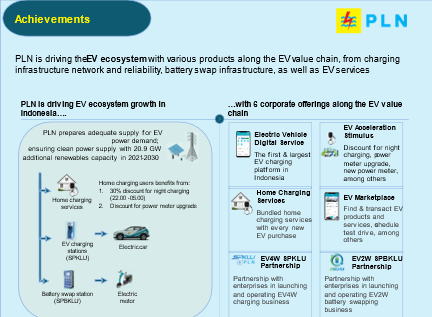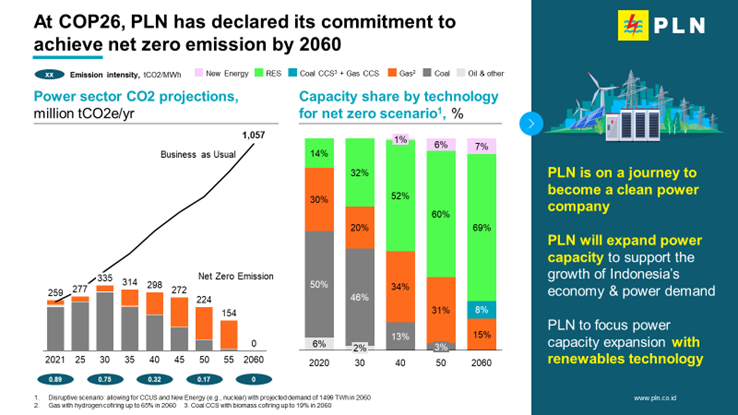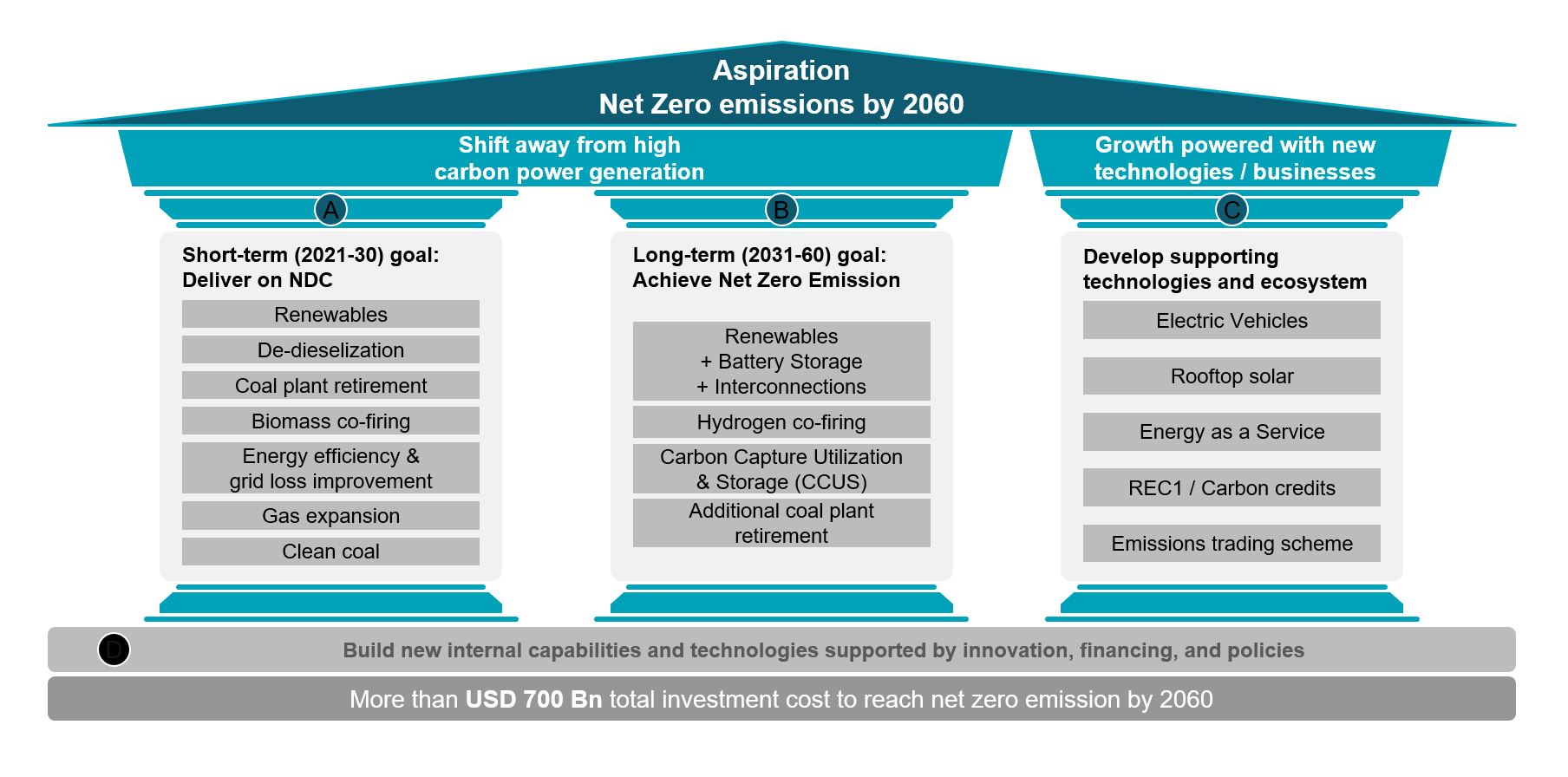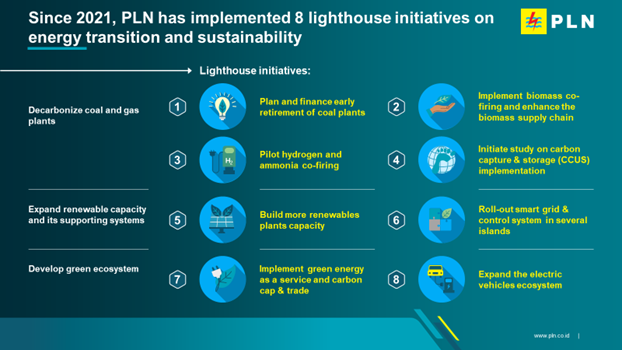At COP 26, PLN has announced its commitment to achieve Net Zero Emissions by 2060. PLN will focus on expanding power capacity using clean energy to support Indonesia’s economic and power demand growth. Under Net Zero Emission scenarios, emissions will peak in 2030 and then gradually decline until they reach Net Zero by 2060. This will reduce 1,057 million ton of greenhouse gas emission in 2060, compared to business as usual scenario.
PLN has developed a comprehensive roadmap to achieve Indonesia’s Nationally Determined Contribution by 2030 and to pursue Net Zero Emissions by 2060. Our strategy is centered on shifting away from high carbon power generation and maintaining growth through new technologies and businesses.
Six strategic initiatives are being and will be implemented to support NDC 2030, namely the development of new and renewable energy-based power plants, the conversion of diesel power plants to renewable energy, the retirement of coal power plants, biomass co-firing, energy efficiency and network losses reduction, and the expansion of gas plants
PLN also has four other strategic initiatives in its long-term strategy to achieve the Net Zero Emissions target by 2060. These include the addition of large scale renewable energy complemented with batteries and grid interconnection, the hydrogen-based co-firing, the adoption of carbon capture and storage (CCS) and the early retirement of coal power plants.
Since COP 26, PLN has implemented eight Lighthouse Iniatiaves on Energy Transition. These Initiatives are manifestation of PLN vision to achieve Net Zero Emission by 2060. By deploying the lighthouse initiatives to PLN units and subsidiaries, PLN ensures that each element in PLN participates in the energy transition agenda.
The eight lighthouses initiatives are divided into three categories. The first category is the decarbonization of coal and gas power plants. The second is to increase renewable capacity and its supporting systems. And, the third is to develop green ecosystems.
PLN initiated the decarbonization of coal and gas plants by planning the financing for coal plant early retirement, implementing biomass cofiring, studying hydrogen & ammonia, and studying carbon capture and storage technology.
To meet Indonesia’s growing electricity demand with green energy, PLN is building more renewable power plants and rolling out smart grids as a support system.
PLN also invites people and businesses to participate in the development of green ecosystems, by enabling renewable consumption through green energy as a service and expanding the electric vehicle ecosystem.
- Early retirement of coal power plants
PLN is driving energy transition by moving away from coal-fired power plants (CFPP) to renewables generation with energy transition mechanism (ETM), as part of the 2060 net zero emission commitment.
Under this initiative, PLN accelerates the phase-out of coal from power system by conducting:
- Decrease the planned coal plant capacity in RUPTL
- Terminating the ongoing coal plant projects in the overall PLN’s project pipeline
- Conditional early retirement of operational coal power plants
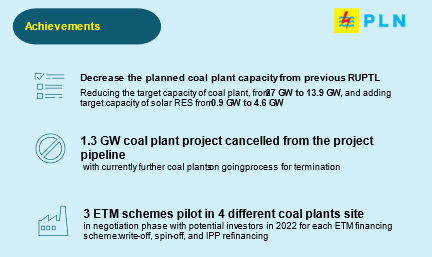
- Biomass Co-Firing
PLN is committed to increase renewable’s share in power generation mix as well as decrease the amount of coal used. One of the immediate actions implemented to achieve this is through biomass co-firing. Biomass co-firing is replacing a portion of coal as feedstock for steam power plants with biomass resources, such as wood pellets, refuse-derived fuels, etc.
The potential supply of biomass produced in Indonesia:
- 544 Mn ton from Forestry resources from energy forest (Hutan Tanaman Energi, “HTE”)
- 73 Mn ton from Agriculture & industrial by-products
- 42 Mn ton from Commercial waste as solid recovered fuel (SRF)
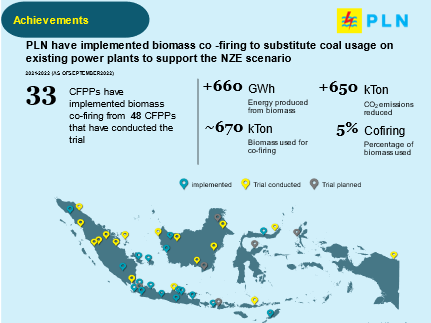
- Hydrogen & Ammonia Co-firing
PLN is committed to decrease the amount of fossil fuels used in thermal power plants. One of the immediate actions implemented to achieve this is through replacing a portion of gas / diesel / coal feedstock with hydrogen and ammonia co-firing.
In short-term, PLN is conducting joint studies with partners and trials to develop hydrogen and ammonia co-firing system in PLN’s steam power plants.
In medium-term, PLN is looking to run hydrogen and ammonia co-firing pilots, supplied by green hydrogen and ammonia to reduce the power plants emissions.
In long-term, PLN is planning to further study hydrogen and ammonia co-firing for implementation beyond 2040 to reduce the thermal power plant emissions.
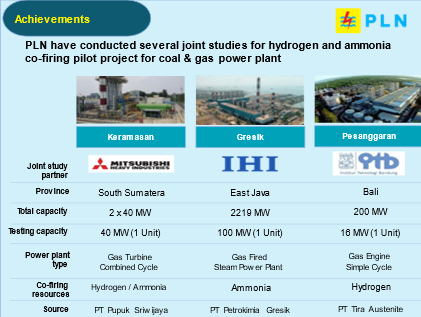
- Carbon Capture & Storage (CCUS) Implementation
Under PLN’s net zero strategy, CCS retrofits are allowed on existing coal and gas plants identified as CCS-ready to reduce unabated carbon emission.
CCS is a technology that capture high-concentration carbon dioxide (CO2) from the point of source for utilization in other industrial activities or storage in deep geological formations.
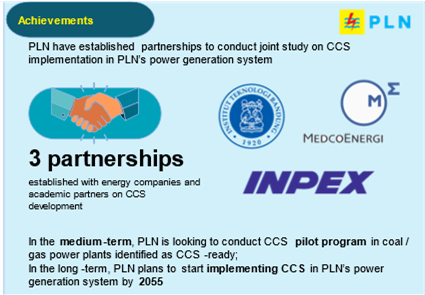
- Renewable Energy Development
PLN is committed to decarbonize the power system by transitioning to new and renewable energy sources to achieve net zero emission by 2060.
In the short-term, PLN has been accelerating new renewable power plant projects to achieve an additional 20.9 GW renewable capacity as planned in RUPTL 2021-2030 (~52% of total new capacity planned for 2021-2030).
To ensure a just transition across Indonesia, PLN is also transforming fossil-based generation in remote areas with de-dieselization project, converting diesel-based generators to solar PV + battery energy storage system (BESS) + hybrid diesel generator as back-up
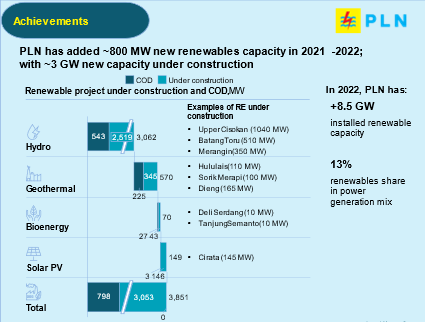
- Green Energy As Service
PLN is enabling stakeholders’ participation in green energy consumption and development with green energy as-a-service.
Two options available under PLN’s Green energy as-a-service products:
- Green energy (dedicated) – where the electricity consumed is bundled with renewable energy certificates, ensuring 100% green energy consumption
- Renewable energy certificates (RECs) – where customers can purchase RECs separately (unbundled) from the electricity, allowing flexibility in green energy coverage
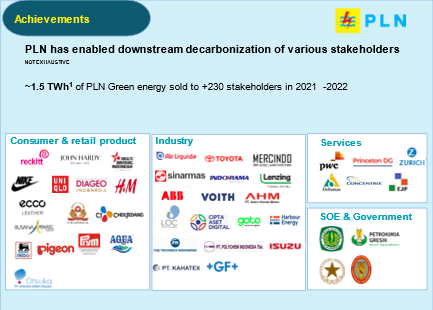
- Smart Grid
PLN is developing and implementing smart grid to increase system efficiency and allow digitized monitoring and management of the power system.
Smart grid is a digitalized electrical network system that can integrate all connected components, starting from generators, transmission equipment, distribution, to consumers. PLN is preparing a smart grid pilot program in power plants, grids, and digitizing meters.
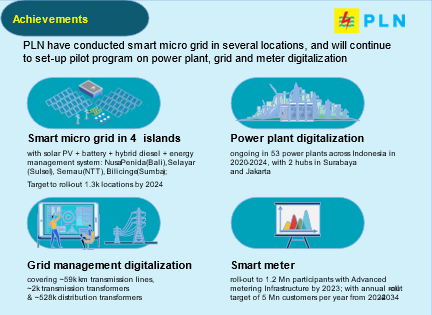
- Electric Vehicle Ecosystem
PLN is ready to be the backbone of Indonesia’s decarbonization journey, not only in the power sector but also in other sectors through electrification with clean energy sources. PLN is committed to support transformation of the transport sector from depending on imported fossil fuels to be based on domestic electricity with electric vehicle (EV), helping Indonesia to achieve energy independency as well as to reduce emissions.
